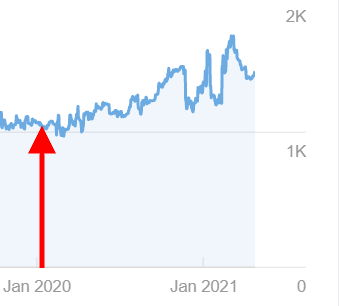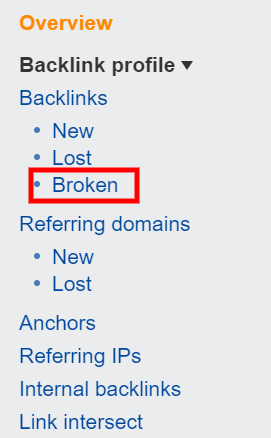How to gain value from broken backlinks
This guide will show you how to profit from broken backlinks, both yours and your competitors’.
When many digital marketers think of link building, they immediately think of the traditional outreach method. One can think of instructions detailing how to write the finest email subject lines when requesting publication, or they might think about how to make the most of HARO. Although these methods can be quite effective, the return on investment is mostly out of your control. Marketers will be scurrying for new sources if not everyone responds positively to emails and pitches.
Fortunately, there are a number of extremely effective link-building strategies that allow marketers more control while also benefiting consumers and website owners. These techniques rely on broken backlinks in particular.
What are broken backlinks?
Broken backlinks happen when an external link from a site points to a non-existent page on another domain, much too broken internal links on sites that bring up 4xx client codes. This happens most often when a page’s URL changes or when the connecting site adds an inaccurate URL.
For a long time, internet professionals have been aware of the tendency for links/pages to become non-existent. This condition is known as “link rot,” and it affects a lot of websites. According to a WooRank analysis, 12.2 percent of backlinks to e-commerce sites go to a 404 page.

Although the study only looked at e-commerce sites, similar tendencies are likely to be observed in other industries. In reality, we can see this in the academic world. According to a Harvard Law Review study published in 2014, up to 20% of backlinks may be dead after just one year, and the number grows over time.

You’re not alone if the rate of link rot astounds you. Backlinks break at an exponential rate, resulting in a huge quantity of link equity being squandered.
Given the frequency of such relationships, it may come as a surprise that these strategies are rarely mentioned by seasoned marketers. This could be due to an overemphasis on the frequently misunderstood “freshness” element, with marketers deciding to focus entirely on getting links from new material rather than examining the chances presented by “older” backlinks.
Old backlinks, on the other hand, can still be useful. Link reclamation and outreach activities can provide marketers with a gold mine of information. All you have to do is pay close attention to broken links referring to both your and your competitors’ websites.
Broken Links: Reclamation vs. Building
Between broken link reclamation and broken link building, there are two key distinctions. The goal of link reclamation is to reclaim the value of broken links leading to your website. Broken link building, on the other hand, is the act of creating new content to replace broken backlinks from your competition.
Both strategies are slightly different, but they both give you more flexibility over link-building outreach than typical ways. If effectively executed, they can also make a huge difference.
Ultimate Whale Watch & Snorkel was one of my clients who had an extremely successful broken backlink effort. Following the start of reclamation and outreach initiatives, organic traffic and ranking keywords (as shown in the graphs below) climbed at considerably higher rates than in previous years during the next year.

Organic traffic for Ultimate Whale Watch & Snorkel. Source: Ahrefs.

The client’s industry is a key consideration here. Despite being in the tourism/travel industry during the COVID-19 pandemic, UWW reported a gain of 171.2 percent in organic traffic and a 257.2 percent increase in organic keywords ranking year over year.
Broken link reclamation and construction efforts, when combined with the other link-building tools in your arsenal, can be quite fruitful. Here are the steps we recommend for both processes:
Broken backlink reclamation
Step 1: Analyze your site’s backlinks.
To begin, figure out how many (if any) backlinks pointing to your website are broken. Ahrefs is an excellent tool for analyzing this data and determining which backlinks are pointing to dead links.
Open Ahrefs and log in, then run an analysis on your domain.

Step 2: Organize your broken backlinks.
Click the “Broken Links” icon in the left-hand menu, which is located under “Backlinks.” After that, you’ll see a list of all the site’s broken backlinks.

The “DR” (domain rating) column might help you organize the broken backlinks in this list. The highest-valued links will be at the top of the list. These can then be exported into a spreadsheet for further analysis.
Step 3: Choose the broken links to go after.
This useful table of information will show you where the backlink came from, what anchor text it has, and what URL it points to. Examine the specified external domains to see if the backlink is worthwhile. You might conclude that some of them are irrelevant, have poor authority, or are simply spam. It’s best to look for backlinks that come from reputable websites and include relevant anchor text.
Step 4: Regain the broken link value.
After you’ve compiled a list of broken backlinks you’d like to reclaim, look over your own website to see which link would be the best replacement.
From here, there are two main paths to take.
- Option A: Contact the site owner of the broken backlink and inform them of the problem. Give them the appropriate replacement link and instruct them to update it. If you point up a broken link on their site and include the live URL, the site admin should be grateful.
- Option B: The site owner may or may not react. In this case, a redirect is an easy way to reclaim the lost link value. Create a 301 (permanent) redirect to a page on your site that is relevant. You’ll reclaim the lost link value this way, and users will land on a live page.
Are 301 redirects effective with broken backlinks?
The quantity of link equity (or PageRank) passed forward via 301 redirects has long been a point of contention among marketers. This is largely due to misunderstandings about how Google and other major search engines handle them.
To clarify the situation, Google’s John Mueller revealed how their search engine employs 301 redirects as canonical URL directives. As a result, if the redirect URL you use isn’t related enough to the original, Google will most likely regard the broken link as a soft 404. A highly relevant reroute, on the other hand, is likely to obtain close to 100% of the ranking benefits.
This is why it’s critical to check that the redirect matches the missing material. You want your redirected URL to be treated as canon by search engines.
Broken link building using competitor data
Step 1: Analyze your competitor’s backlinks.
Choose a rival and use Ahrefs to examine them in the same way as outlined before.
Step 2: Find the relevant broken backlinks.
Sort the broken backlinks into categories based on their importance. Examine your own website to see if you have any content that is related to the link in question. This is the broken link on the third-party site that you’ll be looking to repair.
Step 3: Provide the perfect replacement content.
It’s now time to put together a piece of appropriate substitute material. If you’re starting from scratch, look through the connecting site’s topic — as well as the anchor text — and utilize it as a starting point for your new page. If the content is already available, you’re good to go!
Step 4: Reach out to the site owner.
Once you’ve created a replacement page, contact the site owner via the broken link and inform them of the problem. Offer your piece as a replacement, making every effort to demonstrate how it relates to the content’s theme. No one likes to feature content with errors, so you’ll be astonished at how many site owners take you up on this.
Pay attention to broken backlinks
Broken backlink issues, which impact nearly every site at some point, provide marketers with unique link-building opportunities. Paying attention to these possible relationships could have a significant impact on your campaigns.
The post How to gain value from broken backlinks appeared first on Soft Trending.
from Soft Trending https://ift.tt/3d4nqkh
via softtrending
Comments
Post a Comment